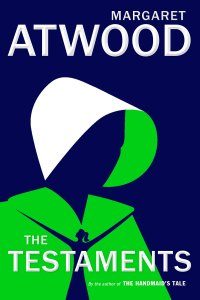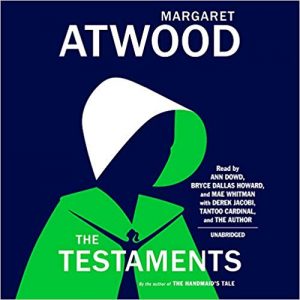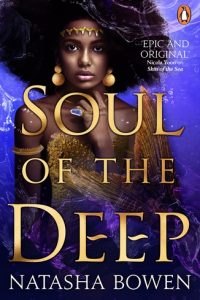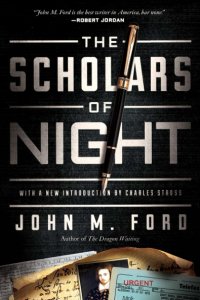Gary K. Wolfe and Amy Goldschlager Review The Testaments by Margaret Atwood
 The Testaments, Margaret Atwood (Doubleday 978-0-385-54378-1, $28.95, 422pp, hc) September 2019.
The Testaments, Margaret Atwood (Doubleday 978-0-385-54378-1, $28.95, 422pp, hc) September 2019.
When Margaret Atwood published The Handmaid’s Tale in 1985, the year after the real-life 1984 and at the height of the Thatcher/Reagan era, figures like Phyllis Schlafly and Jerry Falwell were still ascendant, and the failure of the Equal Rights Amendment in the US was still a raw memory. It made sense to ask, as Atwood did, just how bad things could get. Well, almost 35 years later, we have a pretty good idea of how bad, so it wasn’t too surprising that the novel suddenly popped back on the bestseller lists in 2017, even before anyone had seen the TV series. In The Testaments, set some 15 years after the first novel, the fearsome Aunts still have the occasional lunch at the Schlafly Café and spy on each other like Cold War-era Stasi, which lends a vaguely retro feel to this new version of the Republic of Gilead, even though it’s as oppressive as ever and still has a distressing taste for violent, summary executions. Revisiting a classic dystopia carries its own risks, like making a monster-movie sequel: you can never be quite as shocking as the first time out, especially when your world was as grim as Atwood’s. When Aldous Huxley wrote Brave New World Revisited in 1958, it wasn’t even a novel: he just ticked off the ways in which the world was rushing toward his earlier nightmare scenario. Atwood might have chosen the same route, giving us a narrative that explained the preconditions that led to the founding of Gilead in the first place, but it’s possible that she figured the last three or four years would do just as well. Instead, she’s given us an account of how Gilead begins to unravel – a novel which is part Machiavellian court politics, part espionage adventure, part coming-of-age tale, and, as we would expect from Atwood, all immensely readable.
I always felt that, in The Handmaid’s Tale, Atwood pulled a significant punch by employing the familiar technique of a “future past” framing, adding an epilogue which casts the whole novel as a tale found on cassette tapes sometime after the presumed fall of Gilead, reassuring us that the nightmare didn’t really last (as opposed to, say, Orwell, who pretty much left us with that face-stomping boot forever). In The Testaments, she actually makes more sophisticated use of that technique, in ways that benefit her plotting. The story unfolds in three first-person narratives, all described as documents found after the (now much more explicit) fall of Gilead. One is a handwritten manuscript from Aunt Lydia, the most notorious character held over from the earlier novel and the TV series (which, in an afterword, Atwood seems quite pleased with). The other two are “witness testimonies,” one from the point of view of Agnes, a privileged daughter of Gilead, being groomed to marry a Commander, and the other from the viewpoint of Daisy, being raised by parents who run a used clothing store in Toronto and who seem strangely overprotective. One of the threads that all three narratives have in common is the issue of Baby Nicole, which has been a source of tension between Gilead and Canada ever since she was smuggled into Canada, possibly along the “Underground FemaleRoad,” a conceit which unsubtly draws a parallel between Canada here and the North during the American Civil War.
It’s clear from the beginning that the central plot movement will show how these three stories become intertwined, and how collectively they contribute to the eventual fate of Gilead itself. It’s frankly not that difficult to guess how the arc of each major figure will play out, so that much of the satisfaction late in the novel derives from elements clicking into place in neat melodramatic fashion. Atwood doesn’t spend a lot of time dwelling on the horror-story aspects of Gilead, although there are some pretty grim scenes, and the major male character, Commander Judd, has a disturbing habit of taking a succession of very young wives, each of whom dies under questionable circumstances. Probably the biggest surprise for readers or viewers will be the complex backstory given to Aunt Lydia, a former lawyer, judge, and rape counselor who becomes the brutal nemesis of the Handmaids, but who clearly has an agenda of her own. Her narration is far more self-reflective than we might have suspected (even though she has an annoying predilection for clichés, as does an older mentor named Ada in the Canadian chapters), and her tale forms the spine of the novel. Agnes’s tale gives us a glimpse into the life of the upper-class Gileadeans, and is fascinating in its attempt to describe the struggles of an obviously intelligent girl in a society that expects only obedience. Hers is probably the least credible narrative voice, strikingly articulate for someone kept illiterate for most of her childhood. Daisy – who doesn’t turn out to be Daisy, but that’s a spoiler – is the first chance we’ve seen in either novel to view Gilead from the outside, and as courageous as she is, her immediate willingness to risk her life on a hazardous mission into Gilead isn’t fully convincing – at moments it seems like Katniss Everdeen has somehow wandered into Gilead. Each of these narrators is engaging in her own way – it’s possible Atwood couldn’t write a boring character if she tried – and even when writing flat-out melodrama, her prose is irresistible at the sentence and paragraph level, and her dialogue always rings true. If The Testaments finally seems like a lighter novel than The Handmaid’s Tale, replacing the chilling ambiguity of that novel’s conclusion with something a bit more heroic and hopeful, it may be simply because we need that hope a bit more now that we did in 1985.
-Gary K. Wolfe
This review and more like it in the December 2019 issue of Locus.
 The Testaments, Margaret Atwood; Ann Dowd, Bryce Dallas Howard, Mae Whitman, Derek Jacobi, Tantoo Cardinal, and Margaret Atwood, narrators (Random House Audio 978-0-52559045-3, $45.00, CDs, 13.25 hr., unabridged [also available as a digital download]) September 2019.
The Testaments, Margaret Atwood; Ann Dowd, Bryce Dallas Howard, Mae Whitman, Derek Jacobi, Tantoo Cardinal, and Margaret Atwood, narrators (Random House Audio 978-0-52559045-3, $45.00, CDs, 13.25 hr., unabridged [also available as a digital download]) September 2019.
The academic narrating the epilogue to Margaret Atwood’s now-classic novel The Handmaid’s Tale explains that we can’t always know how a person’s story really ends; sometimes they just drop out of history and we cannot follow. The extra epilogue to the Special Edition of the audiobook (previously reviewed here) and the popular Hulu television show based on the novel both suggest that Atwood’s audience might not have felt so comfortable embracing that kind of ambiguity. They wanted answers about what really happened to Offred, the woman who was ripped away from her husband, child, and comfortable job in a library to become a brood mare for the political elite in Gilead, a Christian fundamentalist nation built on the ruins of the United States.
That fan pressure, as well as Atwood’s openly stated concern about current political views on reproduction, gender roles, and religion, have led to this sequel, which, despite the co-winning of the Booker Prize, is less a work of literature than a pulpy alternate-history thriller with some fairly obvious twists and turns but which occasionally has its moments.
We follow three intertwining story threads. Aunt Lydia, in a characterization not entirely consistent with the first book, narrates her own journey from a family court judge to the feared leader of Gilead’s moral guardians, the Aunts, and reveals her role as a liaison to those who would bring down the regime. Offred’s daughter, Agnes Jemima (that’s not a spoiler; the attentive listener will figure that out at a very early point), recounts her unhappy childhood and adolescence being groomed to be the perfect Wife, while Daisy, a young woman living in Canada, discovers her own link to Gilead in a rather unsettling manner.
Margaret Atwood reads all the part and chapter titles; I guess just to keep her hand in? Ann Dowd is fabulous in the role she plays on the Hulu series, the dour, cynical, and power-hungry Aunt Lydia; she almost makes me not regret this book. Bryce Dallas Howard is lovely as the demure Agnes fumbling her way into self-assurance, and Mae Whitman is appropriately defiant as the well-meaning but rash Daisy, the world’s worst teen undercover agent. Famed actor Derek Jacobi pops in at the end as the epilogue’s narrator, Professor Piexoto (the academic noted above); of course, I can listen to him all day, even if it doesn’t make sense for someone named Piexoto to have an English accent and he’s undercutting the original novel’s message with this story’s resolution that ties up all three plot threads into a far-too-neat and fairly saccharine bow.
Once it was out there, I couldn’t stop myself from wanting to know what happened next, but my more literary instincts wish that Atwood could’ve stopped herself from pandering to me and her other fans, and continued to embrace that ambiguity.
-Amy Goldschlager
This review and more like it in the January 2020 issue of Locus.
Gary K. Wolfe is Emeritus Professor of Humanities at Roosevelt University and a reviewer for Locus magazine since 1991. His reviews have been collected in Soundings (BSFA Award 2006; Hugo nominee), Bearings (Hugo nominee 2011), and Sightings (2011), and his Evaporating Genres: Essays on Fantastic Literature (Wesleyan) received the Locus Award in 2012. Earlier books include The Known and the Unknown: The Iconography of Science Fiction (Eaton Award, 1981), Harlan Ellison: The Edge of Forever (with Ellen Weil, 2002), and David Lindsay (1982). For the Library of America, he edited American Science Fiction: Nine Classic Novels of the 1950s in 2012, with a similar set for the 1960s forthcoming. He has received the Pilgrim Award from the Science Fiction Research Association, the Distinguished Scholarship Award from the International Association for the Fantastic in the Arts, and a Special World Fantasy Award for criticism. His 24-lecture series How Great Science Fiction Works appeared from The Great Courses in 2016. He has received six Hugo nominations, two for his reviews collections and four for The Coode Street Podcast, which he has co-hosted with Jonathan Strahan for more than 300 episodes. He lives in Chicago.
 While you are here, please take a moment to support Locus with a one-time or recurring donation. We rely on reader donations to keep the magazine and site going, and would like to keep the site paywall free, but WE NEED YOUR FINANCIAL SUPPORT to continue quality coverage of the science fiction and fantasy field.
While you are here, please take a moment to support Locus with a one-time or recurring donation. We rely on reader donations to keep the magazine and site going, and would like to keep the site paywall free, but WE NEED YOUR FINANCIAL SUPPORT to continue quality coverage of the science fiction and fantasy field.








As far as Handmaids/TESTAMENTS goes, they both endlessly predict the fall of Gilead, but the fans never actually SEE it. From Mayday to Pearl Girls, the fans see only frantic and desperate attempts by Gilead to keep Gilead’s power. The writers throw out watered down hints that there are cracks in Gileads power structure etc. WE are supposed to believe that Nick has enough unseen counter parts to bring down Gilead
NOT GOING TO FLY WITH FANS.
After all these seasons, PLUS multiple seasons of Testiments, fans have paid their dues. WE HAVE EARNED THE RIGHT TO SEE GILEAD FALL. We deserve to see landing paratroopers, yelling, “we are French, English, Irish, Israeli, YOU ARE FREE, YOU ARE SAFE”!! We Earned, seeing piles of red capes and white bonnets. We deserve to see Commanders, Eyes etc arrested. Yes, it is revenge, the fans have earned that priveledge. As have the Handmaids, both in Gilead and Canada.